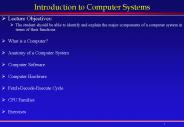Computer Control - PowerPoint PPT Presentation
1 / 55
Title:
Computer Control
Description:
Computer Control Computer Control Basics Input (Sensors) Processing (Black Box) Output (Actuators) Computer Sensors Voltage Producing Sensors Variable ... – PowerPoint PPT presentation
Number of Views:239
Avg rating:3.0/5.0
Title: Computer Control
1
Computer Control
2
Computer Control Basics
- Input (Sensors)
- Processing (Black Box)
- Output (Actuators)
3
Computer Sensors
- Voltage Producing Sensors
- Variable Resistance Sensors
- Variable Voltage Sensors
4
Voltage Producing Sensors
- There are two common types used in vehicles and
equipment - Variable Reluctance Sensors
- Hall Effect Sensors
5
Variable Reluctance Sensors
- These sensors often measure Rotation
- They create their own A/C voltage
- They have many names but work the same
- Magnetic Pulse Generators
- Pickup Coils
- Reluctor Sensors
6
Variable Reluctance Sensor
- Uses a Reluctor that moves past a coil of wire
wrapped around a magnet. - As the reluctor moves the magnetic flux lines,
A/C voltage is induced in the coiled wire. - It uses 2 wires and create its own voltage
- Senses speed and position of rotating objects
7
(No Transcript)
8
(No Transcript)
9
(No Transcript)
10
(No Transcript)
11
Position Sensor
- Output Shaft
Missing teeth identify crankshaft positionOther
teeth measure RPM
12
Hall Effect Sensors
13
(No Transcript)
14
Hall Effect Sensors
- Digital sensor
- Uses 3 wires
- positive voltage, ground and signal voltage
- Senses speed and position
- Can sense very slow rotation speeds
15
(No Transcript)
16
(No Transcript)
17
- Hall Effect Switch
Magnet
3 wiresPower Ground Signal
18
(No Transcript)
19
A/C Analogue SignalNotice position locator
D/C Digital SignalNotice position locator
20
Variable Resistance Sensors
- Thermistor
- Variable Resistor Rheostat Stepped
Resistor
21
Thermistor
22
Variable Resistor
23
Variable Voltage Sensor
- Potentiometer
- Switches
- Fancy Magical Electronic Sensors
24
Potentiometer
Used as a sensor
2 volt
25
Potentiometer
Very low current
4 volt
26
(No Transcript)
27
Switches (Pull-Up)
Biased Low (Signal wire should read ground
volts when unplugged)
28
Switches (Pull-Down)
Biased High (Signal wire should read system
voltage when unplugged)
29
(No Transcript)
30
Computer Actuators
- Relays
- Solenoids
- Stepper Motors
- Indicator Lamps and Display Panels
31
Relay
32
Relay
33
Solenoid
34
(No Transcript)
35
(No Transcript)
36
Normally Closed Solenoid
37
Normally Open Solenoid
38
(No Transcript)
39
Stepper Motor
- Used to control a specific position
- Air Vent
- Cruise Control
- Gauges
- Control Module will Count the steps to know
what position the motor is in
40
Stepper Motors
41
6 steps higher
42
2 steps lower
43
Computer Networks
44
Understand the CAN-BUS Electrical System
- CAN stands for Controller Area Network
- This allows all the computers (controllers) to
talk to each other on one set of wires - BUS refers to a common wire
- Computers talk to each other on a Network where
each Controller shares the same voltage signals
at the same time
45
What Language do computers use?
- Digital
- ON - OFF . High - Low 1 - 0
- Binary code is either 1 or 0 known as a bit
- 8 bits in a Byte
- How many bits in a Kilo Byte? Mega Byte? Giga
Byte? Terra Byte?
46
Computers talk fast!
- Hertz Hz
- Mega Hertz MHz
- Giga Hertz GHz
47
How do computers talk?
- Voltage
- High Low
- On Off
48
What messes up the Communication?
- Open Circuits
- Short Circuits
- EMI
- (Electro Magnetic Interference)
49
What Causes Electro Magnetic Interference?
- Radio Waves
- Electrical Current moving in nearby wires
50
How can you avoid EMI?
- Twist the communication (BUS) wires
- Use a grounded metal shield that surrounds the
BUS wires to absorb the energy of moving magnetic
flux lines
51
120?
120?
52
How can you test for Opens or Shorts in the
CAN-BUS?
- Use an Ohm Meter
- Should read total parallel resistance of CAN
terminals 1 2
53
120?
120?
54
Why do computers need to talk?
- More than one computer may need vital information
55
How do you fix Computers?
- Look for proper sensor input
- If the sensor input is incorrect,
test the sensor and wires - Look for actuator commands
- If the actuator does not respond test
the actuator and the wires































